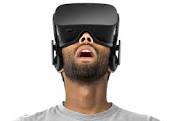
The New York Times has a review of the Oculus Rift, the new virtual reality (VR) product offered by Facebook. VR is designed to create a compelling experience of “presence” in a synthetic three-dimensional world. VR is hyped as the Next Big Thing, but perhaps it will be the next flying car. Even if VR eventually works, the Oculus Rift itself will probably be remembered in the way now recall early mobile phones in light of our iPhones.
So let’s imagine a near-future world in which VR technology is ubiquitous, affordable, and works really well. This post contains my speculations about what such a technology might mean for mental health.

The obvious first VR application is gaming. I’m worried that VR may harm the small group of kids who game addictively. In Addiction, Rooji and his colleagues report on surveys of Dutch school children aged 13-16. They estimate that 1.5% of Dutch kids spend 45 or more hours a week on gaming. Their data suggest that addictive gaming is associated with depressed mood and social anxiety, perhaps because isolated kids are more likely to fall into compulsive gaming. Regardless of the causality, you have to worry that kids who spend that much time in game worlds are stunting their social and cognitive development. If VR makes gaming even more compelling, that won’t help this subset of vulnerable adolescents.
Another possible VR application — this one is considerably farther away — is communication. The idea is that my 3-D avatar will be able to meet your avatar in a synthetic world (perhaps on an overlook in Big Sur rather than a stuffy conference room). The argument is that VR will facilitate better communication because participants will experience the virtual meeting as providing more authentic interpersonal presence than, say, phone or video conferencing. This might happen if, for example, advanced VR headsets can track the movements of the wearer’s eyes and facial musculature. If so, when the wearer looks at something in a synthetic world, his avatar will look at it too, and when he reacts emotionally to an event in that world, so will his avatar. These capacities will greatly enhance our ability to share emotion and identify objects of shared attention, the way we do in ordinary interpersonal encounters.
If all that works, I can imagine doing psychotherapy in a virtual world. This could help solve one of the access problems that plague mental health service delivery. Medications play an increasing role in mental health care. This is happening even though many patients express a preference for psychotherapy and research indicates that for many conditions, psychotherapy works as well as medication or that it can enhance the effects of drugs.
One reason we don’t do more psychotherapy is because it is easier to deliver drug treatment. If you are prescribed medication, what you need to do is to fill the prescription and then take the pills. To get psychotherapy, there has to be a psychotherapist in your community. Unfortunately, therapists like to live in cities, so care is hard to get in rural areas. The therapist has to have openings at a time you can make. You have to be willing to accept a significant cost in travel time associated with each session.
However, virtual psychotherapists can live anywhere and deliver care wherever you are. If you want to see someone after work, there may be a therapist in a time zone such that your 7:00 PM is her 4:00 PM. You don’t have to travel. VR should lower the patient’s cost to access psychotherapy, which would likely expand the market, and perhaps increase the psychotherapy workforce.
Finally, VR might enhance psychological research, one of the basic sciences underneath mental health care. (But please don’t wear your headset in an MRI.) Many psychological experiments involve contrived social interactions, where the experimental subject either interacts with the experimenter’s confederate, or the subject responds to a written vignette describing an interaction. In experiments with live social interactions, the experimenter varies the confederate’s behaviour and studies how subjects’ responses change across that manipulation. In vignette experiments, the experimenter manipulates the content of the vignette. Experiments involving human confederates are closer to real social interactions, but they are challenging to replicate in other laboratories. Experiments using vignettes are far more replicable, but they are weak analogues of real interactions.
However, if you’ve played video games, you’ve encountered non-player characters (NPCs), that is, avatars controlled by the game’s artificial intelligence who can carry out limited social interactions. Imagine a near future world in which AI is good enough to animate an NPC sophisticated enough to take the place of the confederate in a psychological experiment. Then experimenters will be able to carry out live social interactions with wholly programmable confederates. This should allow researchers to run experiments with the verisimilitude of a live interaction and the replicability of a vignette study.
So those are my speculations. Hit me on Twitter if you would like to discuss.

